BIS 2B Midterm 2 Study Guide
1/128
There's no tags or description
Looks like no tags are added yet.
Name | Mastery | Learn | Test | Matching | Spaced |
|---|
No study sessions yet.
129 Terms
What are the three necessary and sufficient conditions for natural selection?
Variation, Heritability, Differential Success
Describe Variation in terms of natural selection.
Individuals vary in the trait (phenotype)
Describe Heritability in terms of natural selection.
The trait is at least partially genetic; individuals
pass on the trait to their offspring
Describe Differential Success in terms of natural selection.
Individuals with different traits differ in their
survival or reproductive success (fitness)
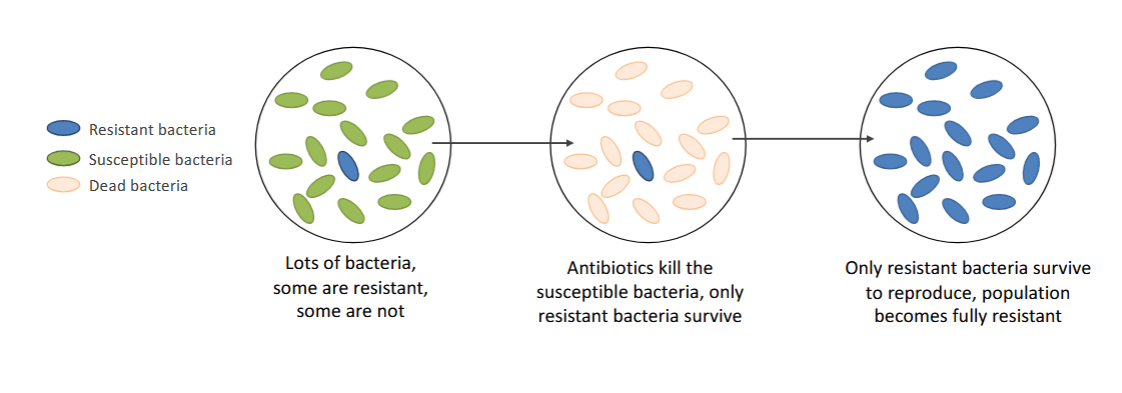
Is this natural selection?
a) yes
b) no
c) ?
a, since variation is satisfied when some bacteria are resistant and some are not. Inheritance is not explicitly specified but we know the resistant bacteria does mitosis and created more resistant bacteria, and differential success since antibiotics kill some bacteria and not others.

Is this natural selection?
a) yes
b) no
c) ?
b, since variation is shown by the different countries, inheritance is shown by the fact its a longevity gene (passed through generations), but differential success is not shown since living to old age doesn’t mean more reproductive success (older people do not reproduce more than people who die at middle age)
Which of the scenarios below would be considered macroevolution?
a. A population of antelope that lives at high elevation for several generations experiences an increase in the frequency of an allele that contributes to increased oxygen levels in the bloodstream
b. A population of songbirds colonizes a remote island system and over several million years diversifies into a dozen different species specialized on different food sources
c. A population of mosquitoes is exposed to an insecticide and over a few generations, develops partial resistance to the insecticide
d. In a population of lizards, two body colors occur, black and light tan. In response to climate warming in recent decades, the light tan coloration has increased in frequency in the population
b
In class, we discussed the frequency-dependent selection example of body color in female dragonflies. In this species, males prefer to mate with the females with the andromoph body color when they are less than half of the population; however, when andromorph body color is present in more than half the female population, males prefer to mate with females of the gynomorph body color. What factor(s) drive(s) body color selection in this system?
Select all that apply
a. Rarity
b. Camouflage
c. Male mate preference
d. Female mate preference
e. Exposure to predators
a, c
![<p><span>After tracking a population of birds for several years, you plot the relationship between wing length and fitness, as shown in the figure below. This figure represents <em>[blank1]</em> selection and the next generation of birds should have <em>[blank2]</em>wing lengths compared to the current generation.</span><br><span>Options for Blank 1: directional, stabilizing, disruptive, no</span><br><span>Options for Blank 2: larger, smaller, similar</span></p>](https://knowt-user-attachments.s3.amazonaws.com/8913f50c-6b2d-44f2-b374-b823fb5e5d41.png)
After tracking a population of birds for several years, you plot the relationship between wing length and fitness, as shown in the figure below. This figure represents [blank1] selection and the next generation of birds should have [blank2]wing lengths compared to the current generation.
Options for Blank 1: directional, stabilizing, disruptive, no
Options for Blank 2: larger, smaller, similar
no, similar
Which of the following are examples of balancing selection? Select all that apply
a. Small plants have higher fitness in summer and large plants have higher fitness in winter, resulting in a population that has both small and large plants
b. When birds lay too many eggs, they can’t provide for them all, but when they lay too few they are more likely to lose them all to predation, resulting in medium-sized clutches
c. Green morphs of an insect species have higher fitness on leaves while brown morphs have higher fitness on bark and branches. Both persist in the population.
d. The establishment of a new highway causes higher fitness for birds with shorter wings because they can veer away from oncoming cars
a, c
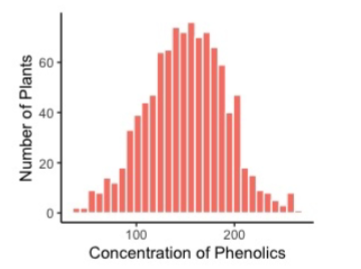
Many plants produce chemical compounds that protect them from predators, either because they make the plants unpalatable (taste bad) or toxic. You hypothesize that a newly invading insect species will cause selection for higher levels of phenolics, a particular type of defensive compound. You measure plants in a meadow that
has not yet been exposed the invasive insect and plot the levels of phenolic compounds in the histogram below. Which of the necessary and sufficient conditions for natural selection does
this data demonstrate?
a. Variation
b. Heritability
c. Differential Success
d. All of them
e. None of them
a
You are in charge of a strawberry breeding program and are trying to use artificial selection to breed larger strawberries. Your most recent crop has an average berry size of 11.5 grams. You
choose a subset of plants that make the largest berries to breed for the next generation. The average berry size for this subset is 12.8 grams. After breeding, the next generation has an average berry size of 12.2 grams
a. What is the response to selection in this system?
b. What is the heritability of this trait?
a. R = 12.2-11.5 = 0.7
b. h² = R/S = 0.7/(12.8-11.5) = 0.538
In class, we discussed selection for body size in male salmon. In this species, males compete through fighting over the right to release their sperm over a female’s nest of eggs. Larger males
are more likely to win these fights and have higher fitness. Small males, however, do not draw the attention of large males and so can sneakily release sperm over a nest without fighting.
Consequently, very large males and very small males have higher fitness than medium-sized males (who are too small to win fights, but too large to avoid a fight)
a. What factor drives the selection of body size in this species?
b. What pattern of selection does it produce?
a) intrasexual competition
b) diversifying/disrupting
How is frequency-dependent selection similar to and different from directional selection?
similar: phenotypes at one extreme have the highest fitness
different: in directional, whats beneficial is not what the phenotype is, but how common it is. While in frequency dependent it is based on the phenotypes benefit.
Under what conditions would altruism be supported by natural selection?
kin selection: selection that favors behaviors that increase the reproductive success of relatives
inclusive fitness: the sum of an individuals own fitness, and its contribution to the fitness of relatives
What types of factors constrain the process of natural selection? Phrased another way, why does natural selection not always result in organisms that are ‘perfectly’ adapted to their environment?
environmental variation/change
laws of physics
evolutionary history
tradeoffs
lack of genetic variation
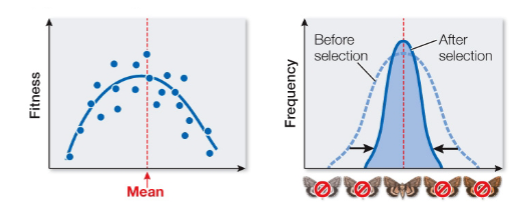
Describe in words the relationships shown in the graphs at below. Label each pair as illustrating directional selection, stabilizing selection, or disruptive selection
Stabilizing selection:
Phenotypes nearest the mean have the highest fitness. The mean stays the same, variation is reduced
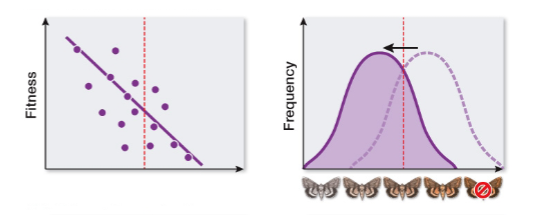
Describe in words the relationships shown in the graphs at below. Label each pair as illustrating directional selection, stabilizing selection, or disruptive selection
Directional selection:
Phenotypes at one extreme have the highest fitness. Mean trends toward that extreme
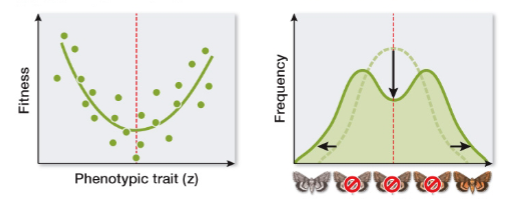
Describe in words the relationships shown in the graphs at below. Label each pair as illustrating directional selection, stabilizing selection, or disruptive selection
Disruptive (Diversifying) selection:
Phenotypes at both extremes have higher fitness than the mean. Variation is increased, bimodal pattern emerges.
Bacteria are asexual organisms, and a bacterium reproduces by duplicating its DNA and splitting into two separate cells. If a single bacterial cell that is sensitive to vancomycin (an antibiotic) is placed in an environment that contains vancomycin, it will die. Now consider another single bacterial cell, also sensitive to vancomycin, that is allowed to divide for many generations into a larger population. If this population is placed into vancomycin-containing environment, some bacteria will grow.
a. Why do you see growth in the larger population (that is allowed to divide), but not with the single cell?
b. Which of the populations meets the conditions for natural selection? What type of selection is occurring?
a. as bacteria divide, some may experience genetic mutation so the larger colony may have some bacteria that are immune to vancomycin and therefore that part of the population may grow.
b. a single cell does not meet the criteria, since there is no variation and differential success. There also may not be heritability since it is not reproducing. The larger colony though meets the requirements, variability since some are immune and some are not, differential success since some die and some don’t, and heritability since the part of the population with the genetic mutation grows.
You are studying whether harvesting large fish from a population will select for smaller body size in the fish. You create an experimental population of fish, all the same age. The average body size of your experimental population is 100 grams. You then harvest the largest fish, removing them from the population and preventing them from reproducing. The average body size of the
remaining fish is 75 grams. The fish remaining are all allowed to breed. What is the predicted body size for their offspring if heritability (h2) of body size is....
a. 1
b. 0.5
c. 0
a. 75
b. 87.5
c. 100
A diploid cell of yeast has 32 chromosomes. How many chromosomes are in each of its haploid spores?
a. 32
b. 16
c. 8
d. 64
b
A human female has __________ chromosomes in each skin cell and __________ chromosomes in each egg.
a. 46; 46
b. 23; 46
c. 46; 23
d. 23;23
e. 92; 46
c
What is the final product of gene expression?
a. A DNA molecule
b. An RNA molecule
c. A protein
d. A ribosome
e. An amino acid
c
What is the product of transcription?
a. A gene
b. A protein
c. RNA
d. A chromosome
e. RNA polymerase
c
A woman is heterozygous for a gene with two alleles, A and a. Assuming that meiosis occurs normally, which of the following represent eggs that she can produce? Select all that apply
a. A
b. a
c. Aa
d. AA
e. aa
a, b
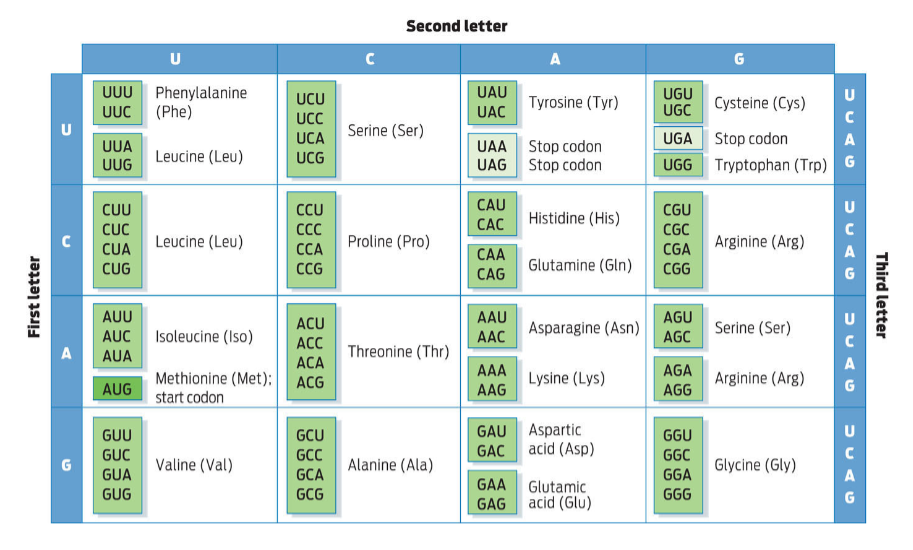
Use the table above to determine which of the 20 amino acids fall into each category. “Wobble” pairings occur when multiple codons produce the same amino acid. For example, UUU and UUC both
code for Phenylalanine, so we would say these codons have wobble pairing in the third codon position.
Which amino acids are coded for by only one codon?
Methionine (AUG) and Tryptophan (UGG)
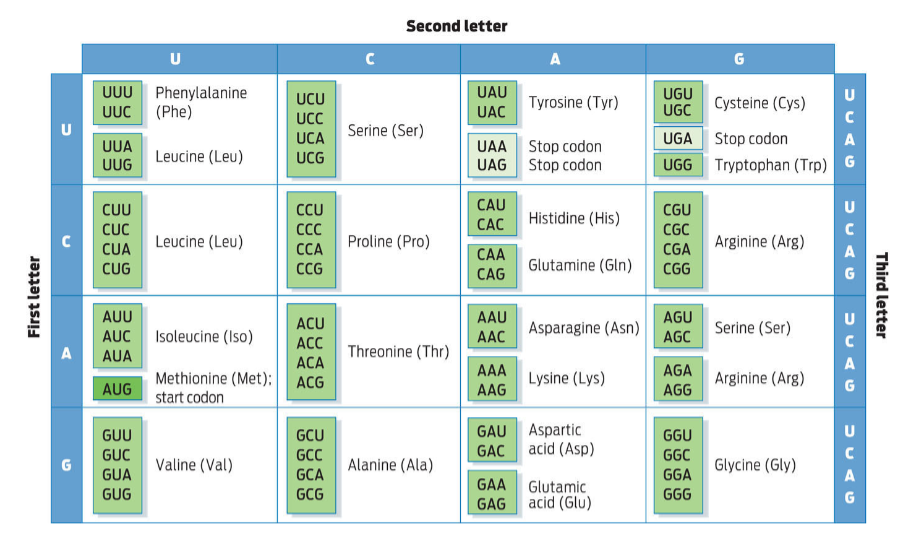
Use the table above to determine which of the 20 amino acids fall into each category. “Wobble” pairings occur when multiple codons produce the same amino acid. For example, UUU and UUC both
code for Phenylalanine, so we would say these codons have wobble pairing in the third codon position.
Which amino acids have wobble pairings in the third codon position?
Phenylalanine, Leucine, Isoleucine, Valine, Serine, Proline, Threonine, Alanine, Tyrosine, Stop, Histidine, Glutamine, Asparagine, Lysine, Aspartic acid, Glutamic acid, Cysteine, Arginine, and Glycine.
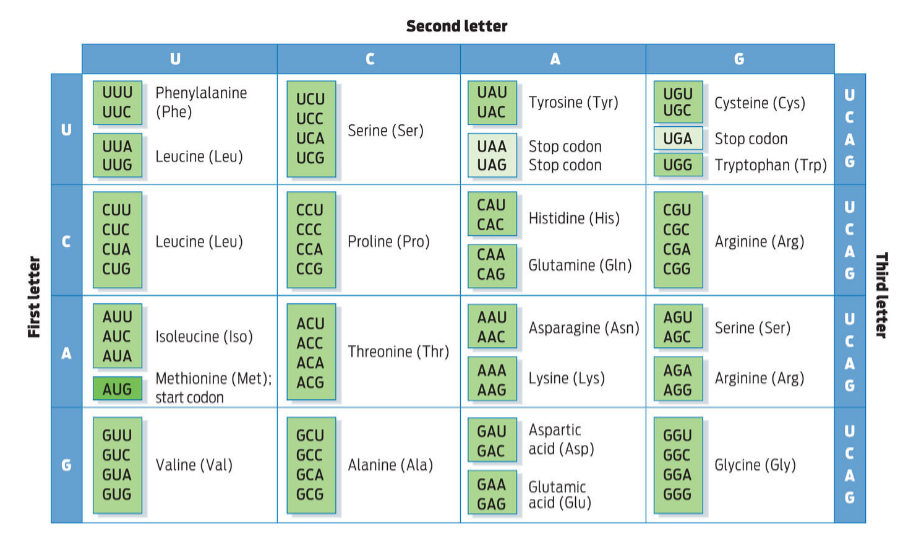
Use the table above to determine which of the 20 amino acids fall into each category. “Wobble” pairings occur when multiple codons produce the same amino acid. For example, UUU and UUC both
code for Phenylalanine, so we would say these codons have wobble pairing in the third codon position.
Which amino acids have wobble pairings in the second codon position?
Stop and Serine (if coupled with wobble in the first position)
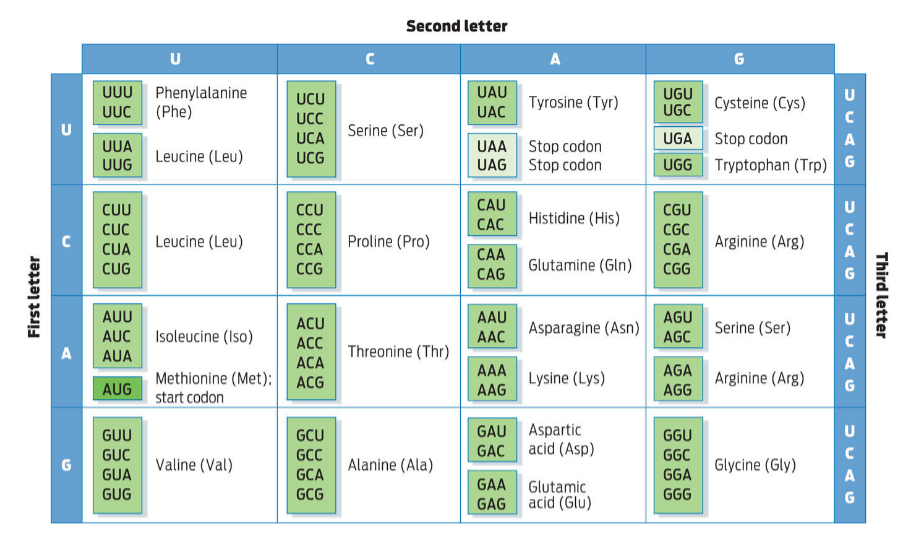
Use the table above to determine which of the 20 amino acids fall into each category. “Wobble” pairings occur when multiple codons produce the same amino acid. For example, UUU and UUC both
code for Phenylalanine, so we would say these codons have wobble pairing in the third codon position.
Which amino acids have wobble pairings in the first codon position?
Leucine, Arginene, and Serine (if coupled with wobble in the second position)

Use the table above to determine which of the 20 amino acids fall into each category. “Wobble” pairings occur when multiple codons produce the same amino acid. For example, UUU and UUC both
code for Phenylalanine, so we would say these codons have wobble pairing in the third codon position.
Which amino acid could have substitution mutations in all three positions of the codon and still produce the same amino acid?
Serine

Use the table above to determine which of the 20 amino acids fall into each category. “Wobble” pairings occur when multiple codons produce the same amino acid. For example, UUU and UUC both
code for Phenylalanine, so we would say these codons have wobble pairing in the third codon position.
It is hypothesized that wobble evolved in order to protect the DNA from harmful effects of mutations. If that hypothesis is correct, which codon position (1st, 2nd, or 3rd) would you predict has the highest rate of mutation?
If this hypothesis is correct, the 3rd position likely has the most mutations since that is the one best ‘protected’ by wobble. The third position does in fact have mutations more often than the 1st or 2nd
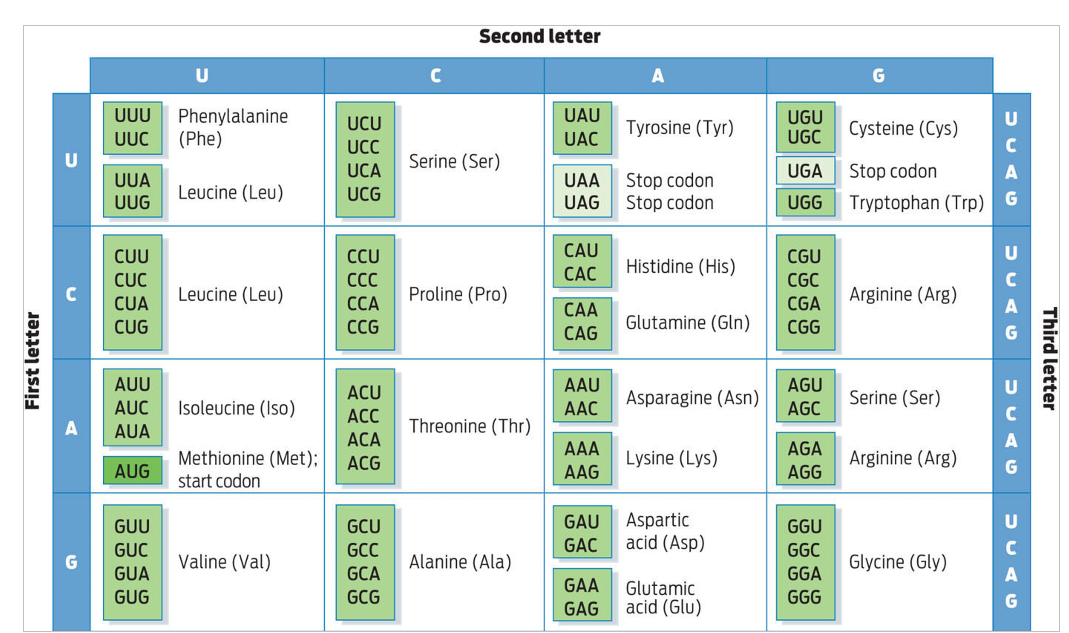
For each gene below, use the codon table to determine the amino acid chain that will be produced by transcription and translation
DNA sense strand ATG TCA CAT TTT GAC TGG CGT CTC GAA TAG
DNA anti-sense strand TAC AGT GTA AAA CTG ACC GCA GAG CTT ATC
mRNA strand AUG UCA CAU UUU GAC UGG CGU CUC GAA UAG
amino acid chain MET, SER, HIS, PHE, ASP, TRP, ARG, LEU, GLU, STOP
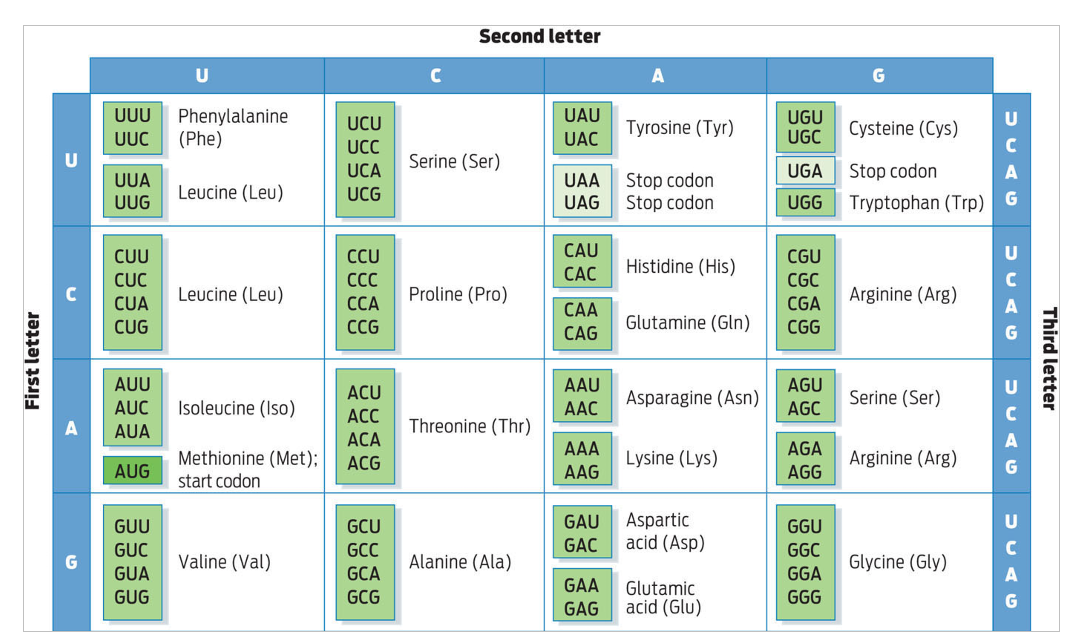
For each gene below, use the codon table to determine the amino acid chain that will be produced by transcription and translation
DNA sense strand ATG AAA CCC GGG TTT ATT CTT AAC AGA CGT CCG ATA TAA
DNA anti-sense strand TAC TTT GGG CCC AAA TAA GAA TTG TCT GCA GGC TAT ATT
mRNA strand AUG AAA CCC GGG UUU AUU CUU AAC AGA CGU CCG AUA UAA
amino acid chain MET, LYS, PRO, GLY, PHE, ISO, LEU, ASN, ARG, ARG, PRO, ISO, STOP
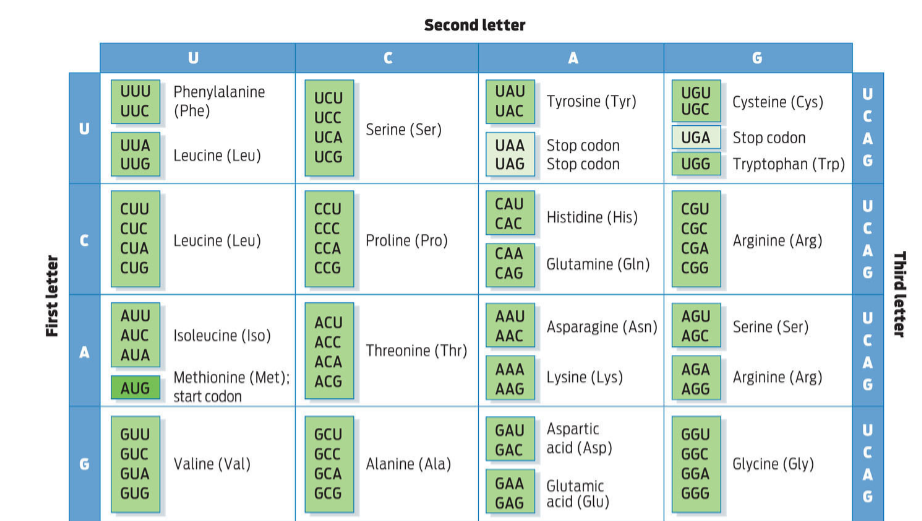
For each gene below, use the codon table to determine the amino acid chain that will be produced by transcription and translation
DNA sense strand ATG GTT ATT GAG ACT TTG CAG CGA CGT AGA TAC AAT TGA
DNA anti-sense strand TAC CAA TAA CTC TGA AAC GTC GCT GCA TCT ATG TTA ACT
mRNA strand AUG GUU AUU GAG ACU UUG CAG CGA CGU AGA UAC AAU UGA
amino acid chain MET, VAL, ISO, GLU, THR, LEU, GLN, ARG, ARG, ARG, TYR, ASN, STOP
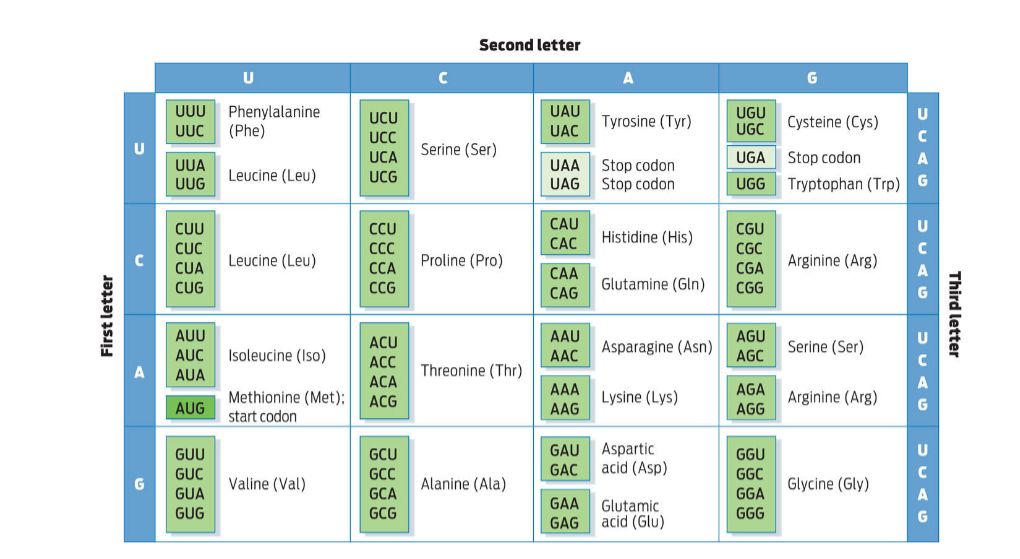
For the following questions, refer to Gene 3 in the question above.
a. What substitution mutation in Gene 3 above would produce the following amino acid chain?
Met, Val, Iso, Glu, Thr, Trp, Gln, Arg, Arg, Arg, Tyr, Asn, (stop)
Gene 3:
mRNA strand AUG GUU AUU GAG ACU UUG CAG CGA CGU AGA UAC AAU UGA
amino acid chain MET, VAL, ISO, GLU, THR, LEU, GLN, ARG, ARG, ARG, TYR, ASN, STOP
Only the sixth amino acid is different. Trp is coded for by the codon UGG, so the mutation must have been a substitution of G for U in the 2nd position of the 6th codon.
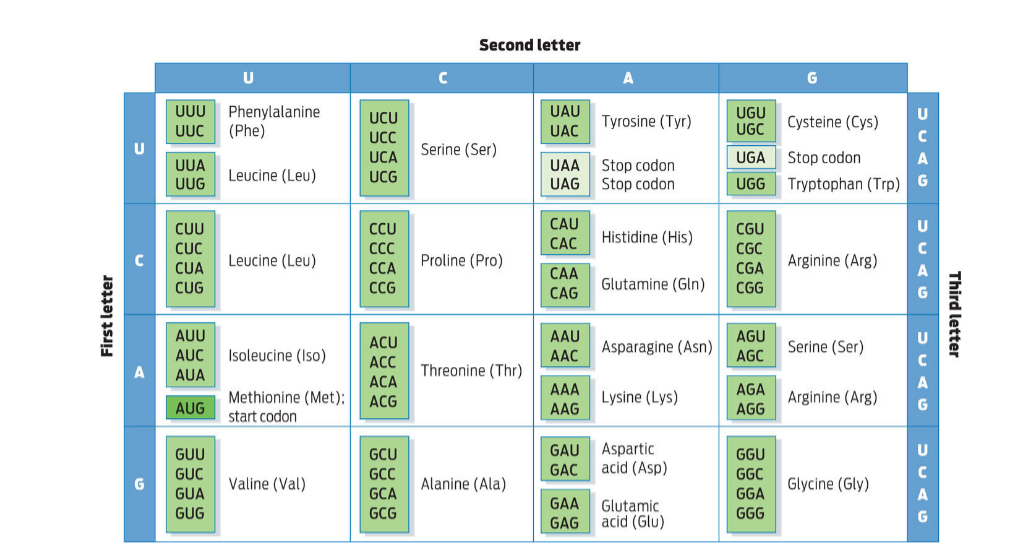
For the following questions, refer to Gene 3 in the question above.
b. What substitution mutation in Gene 3 above would produce the following amino acid chain?
What frameshift mutation would have the same effect?
Met, Val, Iso, (stop)
Gene 3:
mRNA strand AUG GUU AUU GAG ACU UUG CAG CGA CGU AGA UAC AAU UGA
amino acid chain MET, VAL, ISO, GLU, THR, LEU, GLN, ARG, ARG, ARG, TYR, ASN, STOP
Substitution mutation: the correct codon is GAG, a substitution of U for G in the first position would create this amino acid chain
Frameshift: Since UGA is also a stop codon, an insertion of a U between the third and fourth codons would also produce this effect
Which of the following would not be likely to produce phenotypic variation? select all that apply
a. Differences in the amount of mRNA transcription for a pigment gene in birds
b. A synonymous mutation in the gene controlling horn formation in horned beetles
c. A mutation that changes the folding pattern for a protein important to immune function in wasps
d. A deletion causing the removal of several whole genes in a population of grasses
e. In a human population, a mutation in a region of the genome that does not contain any genes
c, d, e
You are interested in two genes in seahorses. The first determines whether there is a spotting pattern, where individuals with the dominant R allele are spotted and rr individuals are plain. The second gene determines color, where individuals with the dominant G allele are bright green and gg individuals are dull green. You breed two heterozygous individuals expecting to get all possible combinations of color and pattern. Out of 1000 offspring, nearly all are bright green with spots (R_G_) or dull green and plain (rrgg). Only 2% of offspring are bright green plain (R_gg) or dull green spotted (rrG_).
Which of the following is a likely explanation for this phenomenon:
a. The two genes are on different chromosomes
b. The two genes are very close together on the same chromosome
c. The two genes are very far apart on the same chromosome
d. The traits are not actually genetic
b
Match each scenario with the type of inheritance it describes. Options are codominance, incomplete dominance, simple dominance, pleiotropy, environmental effects on phenotype, polygenic inheritance, and epistasis.
a. At a gene in horses, homozygous dominant individuals are brown, homozygous recessive individuals are white, and heterozygous individuals have brown and white spots
b. At a gene in bison, homozygous dominant individuals have straight beards, homozygous recessive individuals have curly beards, and heterozygous individuals have wavy beards
c. At a gene in geckos, homozygous dominant and heterozygous individuals have red splotches on their back, homozygous recessive individuals have blue splotches on their back
d. At a gene in butterflies, homozygous recessive individuals have shorter antennae and fewer spots on their wings than heterozygous or homozygous dominant individuals
e. In bunnies, coat color is controlled by a single gene that produces a black pigment. This pigment degrades at temperatures near the bunny’s average body temperature and so most of the
bunny is white. Parts of the bunny’s body that are cooler (the tips of the ears, toes, tail, and nose) accumulate some pigment and are gray.
f. In humans, eye color is controlled by several genes; more dominant alleles across all the genes produce darker eye colors and fewer dominant alleles produce lighter eye colors.
g. At a gene in fescue grass, homozygous dominant and heterozygous individuals produce brown seed pods, while homozygous recessive individuals produce black seed pods, so long as their genotype at a second gene is also homozygous dominant or heterozygous. If the genotype at the second gene is homozygous recessive, however, no pigment is produced and the seed pods are white.
a. codominance
b. incomplete dominance
c. simple dominance
d. pietropy
e. environmental effects on phenotype
f. polygenic inheritance
g. epistasis
What is codominance in inheritance?
the heterozygote phenotype is both of the homozygous phenotypes expressed fully (example: red is dominant, white is recessive, codominance would be red and white spots.)
What is incomplete dominance in inheritance?
the heterozygote phenotype is an intermediate between the two homozygous phenotypes (example: red is dominant, white is recessive, incomplete dominance is pink)
What is simple/complete dominant in inheritance?
a single dominant allele produces the dominant phenotype. The homozygous dominant and heterozygous genotypes have the same phenotype. (example: red is dominant, white is recessive. simple dominant would be red)
What is pleiotropy in inheritance?
the phenomenon where a single gene influences two or more distinct phenotypic traits
What is environmental effects on phenotype in inheritance?
When the environment can change the phenotype of an organisms, for example the PH of soil can change the color of Hydrangea’s.
What is polygenic inheritance in inheritance?
when the inheritance of a trait governed by more than one genes, specifically where multiple genes each have a small cumulative effect on a single trait
What is epistasis in inheritance?
when multiple genes interact to determine the phenotype, specifically where one gene affects the expression of another gene (masking of modifying the effect)
What is the difference between genotype and phenotype?
Genotype is the genetic makeup of an organism (the alleles it carries), phenotype is the traits it exhibits (its physical appearance). The phenotype is determined by the genotype and by the environment
What is the difference between heterozygous and homozygous?
Heterozygous means having two different alleles for a given gene, homozygous means two copies of the same allele
If you know purple flower color is dominant over white flower color, is a white flower heterozygous or homozygous? Explain your answer.
To exhibit the recessive phenotype, the white flower must be homozygous recessive
If you know purple flower color is dominant over white flower color, is a purple flower heterozygous or homozygous? Explain your answer.
The dominant phenotype is exhibited by both the homozygous dominant genotype and the heterozygous genotype. Given only this information, we cannot be sure of the genotype of this plant.
How do each of the following contribute to genetic diversity in a population? Why is genetic diversity important?
a. Sexual reproduction
b. Independent assortment
c. Recombination
Genetic diversity is important for maintaining a healthy population and responding to new selective pressures
a. ‘shufffles’ whole genomes from two different individuals
b. ‘shuffles’ sets of chromosomes and allows an organism to make millions of genetically unique gametes
c. ‘shuffles’ alleles on a given chromosome, creates new chromosome combinations different than what the organism inherited
In squash, white flower color (allele R) is dominant over yellow flower color (allele r). Draw a Punnett Square demonstrating each cross. Include the genotype and phenotype of the offspring. Note: the x in each line stands for ‘crossed with’
a. RR x rr
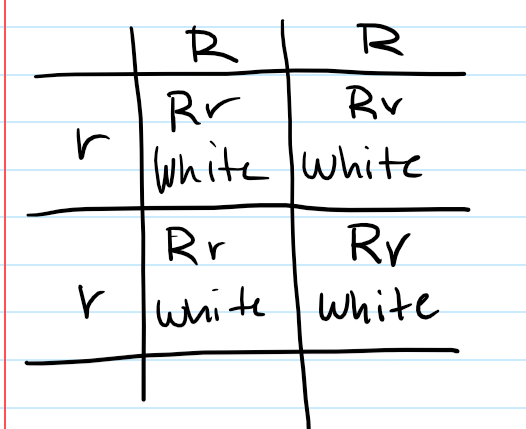
In squash, white flower color (allele R) is dominant over yellow flower color (allele r). Draw a Punnett Square demonstrating each cross. Include the genotype and phenotype of the offspring. Note: the x in each line stands for ‘crossed with’
b. Rr x rr
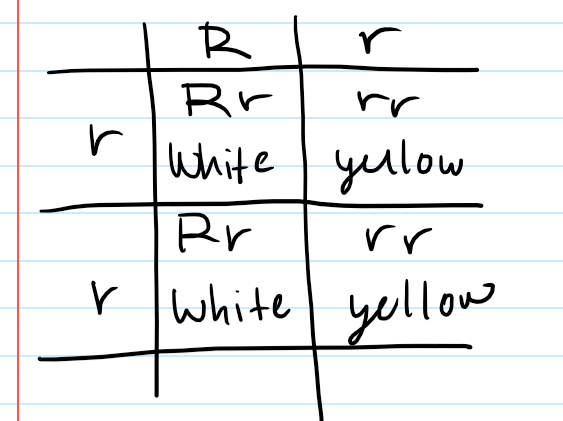
In squash, white flower color (allele R) is dominant over yellow flower color (allele r). Draw a Punnett Square demonstrating each cross. Include the genotype and phenotype of the offspring. Note: the x in each line stands for ‘crossed with’
c. Rr x Rr

For each example below, complete a Punnett Square for the cross described. If letters denoting the allele are not provided, choose your own letters to represent each allele. All traits show complete
dominance. Make sure to provide the genotypes and phenotypes of the offspring.
a. A tall plant (TT) is crossed with a short plant (tt)
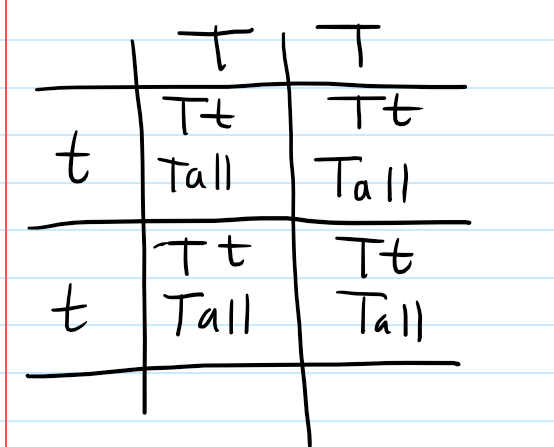
For each example below, complete a Punnett Square for the cross described. If letters denoting the allele are not provided, choose your own letters to represent each allele. All traits show complete
dominance. Make sure to provide the genotypes and phenotypes of the offspring.
b. A green pea (Gg) is crossed with a yellow pea (gg)

For each example below, complete a Punnett Square for the cross described. If letters denoting the allele are not provided, choose your own letters to represent each allele. All traits show complete
dominance. Make sure to provide the genotypes and phenotypes of the offspring.
c. A homozygous recessive tan mouse is crossed with a homozygous dominant brown mouse

For each example below, complete a Punnett Square for the cross described. If letters denoting the allele are not provided, choose your own letters to represent each allele. All traits show complete
dominance. Make sure to provide the genotypes and phenotypes of the offspring.
Two heterozygous white rabbits mate (brown is the recessive color)

Many animals and plants bear recessive alleles for albinism, a condition in which homozygous individuals completely lack any pigments. If two normally-pigmented persons heterozygous for the
albinism allele mate, what percentage of their offspring would you expect to be albino?
25%
You cross a plant with red flowers and a plant with white flowers, expecting to get some red-flowered plants and some white-flowered plants. Instead, you get all pink-flowered plants. What happened?
What were the genotypes of the initial plants?
From your prediction, you believed this trait was complete/simple dominant and that your red-flowered plant was heterozygous. The results of your cross indicate that the trait is actually intermediate/incomplete dominant and your plants were both homozygous.
In tomatoes, the texture of the skin may be smooth or ‘hairy’ (like a peach). You cross a hairy-fruited plant with a smooth-fruited plant and produce an F1 generation of all smooth-fruited plants. A cross
between these F1 offspring produces an F2 generation of 174 hairy fruited plants and 520 smooth fruited plants. Which phenotype is dominant? What were the genotypes of the initial parents?
The smooth fruited plants are dominant, the genotypes of the parents were homozygous dominant and homozygous recessive
A brown mink is crossed with a silverblue mink, and all the offspring are brown. When these F1 brown minks mate, they produce 47 brown offspring and 15 silverblue offspring. Determine the genotypes of the original brown and silverblue mink, the genotypes of the F1 generation and the genotypes of the F2 generation. What fraction of the F2 individuals would you expect to be homozygous?
The genotypes of the original brown and silverblue mink were homozygous dominant and homozygous recessive, respectively. The F1 generations were all heterozygous. The F2 generation has homozygous dominant, recessive, and heterozygous. I would expect 1/2 of the F2 individuals to be homozygous.
In pea plants, tall stems are dominant to short stems, and purple flower color is dominant to white flower color.
a. If a homozygous tall, white plant is crossed with a homozygous short, purple plant, what will be the phenotype of the F1 generation?
b. If an F1 plant from this cross is then crossed with to a homozygous tall white plant, what will be
the possible phenotypes of the offspring, and in what expected proportions?
a. purple and tall
b. 50% tall purple, 50% tall white
Two plants that are heterozygous for seed color (yellow is dominant, green is recessive) and seed texture (smooth is dominant, wrinkled is recessive) are crossed. (Hint: this is called a dihybrid cross, you will need a large Punnett Square, refer to Fig 12.4 in the textbook for assistance).
a. What percentage of the offspring would you expect to have smooth green seeds?
b. What percentage of the offspring would you expect to have wrinkled yellow seeds?
c. What percentage of their offspring would you expect to be heterozygous for both traits?
a. 3/16
b. 3/16
c. 1/4
Flower color in the blue-eyed Mary (Collinsia parviflora) is controlled by two separate genes. The first controls the color of pigment and is called the ‘blue’ gene. The dominant allele (B) produces blue flowers, while recessive alleles (b) produces magenta flowers. This trait exhibits simple dominance, so heterozygote plants (Bb) also have blue flowers. The second gene, called the ‘white’ gene, produces a compound that is required for the pigment of the B gene to be produced correctly. This trait also
exhibits simple dominance, so flowers with genotype FF or Ff will exhibit whatever flower color is indicated by the blue gene. Plants that are homozygous recessive (ff), however, will exhibit no
pigmentation in their petals and will produce only white flowers regardless of their genotype at the blue gene.
What flower color will each genotype listed below produce?
a. BBFF
b. Bbff
c. BbFf
d. bbFf
e. You own a white flowered-plant and a magenta-flowered plant. Crosses between your two plants always produce blue-flowered plants. What are the genotypes of the parent plants? What are the genotypes of the offspring?
a. Blue
b. White
c. Blue
d. magenta
e. magenta parent: bbFF
white parent: BBff
In a certain type of flower, the dominant color is blue (B) and the recessive color is red (b). Two heterozygote blue flowers are crossed.
a. What are the potential genotypes of this cross?
b. What are the potential phenotypes of this cross if this trait exhibits simple dominance?
c. What are the potential phenotypes of this cross if this trait exhibits co-dominance?
d. What are the potential phenotypes of this cross if this trait exhibits intermediate dominance?
a. BB, Bb, bb
b. Blue, red
c. Blue, blue and red splotches, red
d. blue, purple, red

Blood type in humans is controlled by two genes, one which controls ‘type’ (A, B, or O) and the other which controls Rh factor (positive or negative). At the first gene, the A and B alleles exhibit complete dominance over the O allele, and the A and B alleles exhibit codominance with each other. At the second gene, the Rh-positive allele (+) exhibits complete dominance over the Rh-negative allele (-). In the table below, fill in the phenotype (blood type) for each genotype. For example, the genotype BO+/-
has a B allele and an O allele at the first gene; an Rh-positive allele and an Rh-negative allele at the second gene, which results in the blood type B-positive.

Two parents believe their baby was switched at the hospital with someone else’s child. The parents have blood types A-positive and B-positive, and the baby has blood type O-negative. Do the blood
types indicate this baby does not belong to these parents?
If parent 1 is A type, that means they could be AA+/+, AA+/-, AO+/+ or AO+/-. If parent 2 is B type, that means they could be BB+/+, BB+/-, BO+/+ or BO+/-. Since both parents could be heterozygous for both traits: (AO+/- and BO+/-) then they could have a OO- baby. Therefore, there is no evidence the baby was switched.

In humans, a single gene found on the X chromosome controls for the disease hemophilia. Individuals with hemophilia lack a protein required for clotting blood. When injured, hemophiliacs bleed
excessively, and may even bleed to death after relatively minor cuts or bruises. The hemophilia gene has two alleles, H and h. The trait exhibits simple dominance, with the dominant phenotype of normal
protein production (XH) and the recessive phenotype of hemophilia (Xh). In the table below, indicate the sex of each patient, and whether he or she is healthy, a carrier (carries the hemophiliac gene, but does not suffer from the disease), or a hemophiliac.
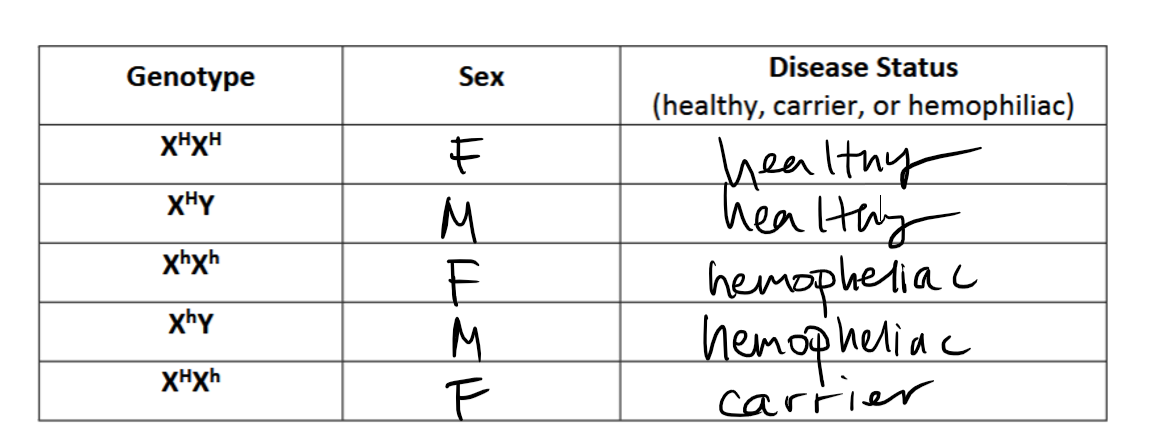
Show the cross of a man who has hemophilia and a woman who is a carrier. What is the probability that their children will have the disease? How does that probability change with the sex of the child?
50%, probability doesn’t change
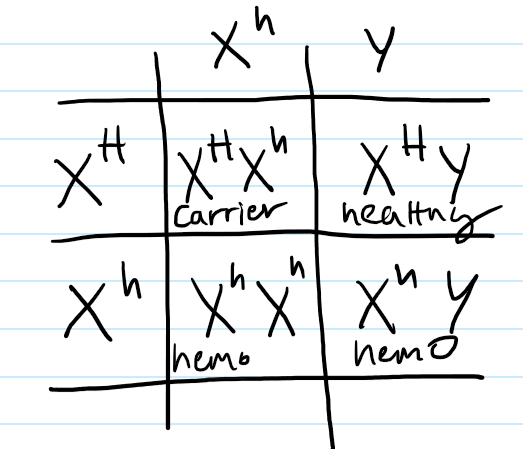
A woman who is a carrier of hemophilia has children with a non-hemophilliac man. Show the cross and determine the probability that their children will have hemophilia. What sex will any hemophiliac children be?
25%, Male
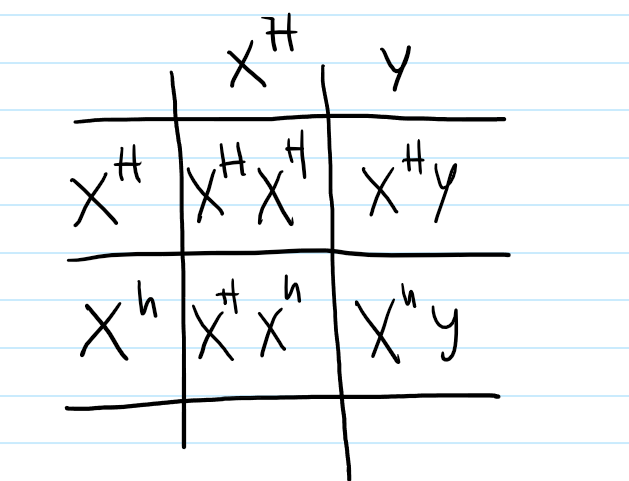
A woman who has hemophilia has children with a non-hemophiliac man. Show the cross and determine how many of their children you would expect to have hemophilia and what the sex of the hemophiliac children will be.
½ of children will have hemophelia, Male
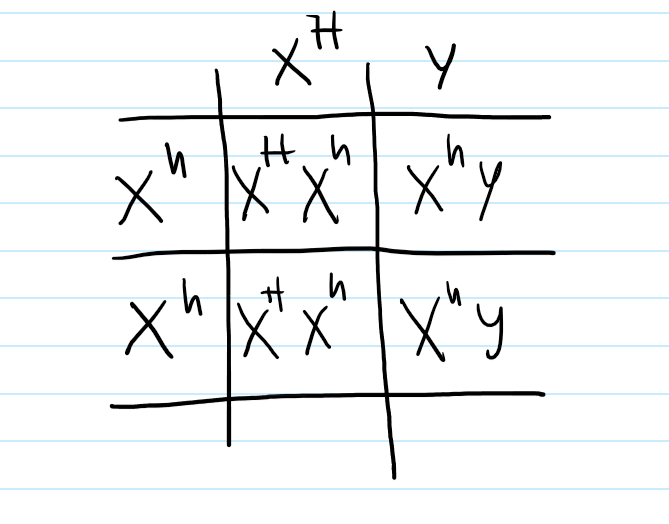
Why are X-linked recessive diseases more common in men than women?
Since men only have one X chromosome, a single disease allele will cause them to exhibit the disease. With two X chromosomes, women must inherit two disease alleles in order to exhibit the disease. Since these alleles are often somewhat rare, it is less likely for a woman to inherit two disease alleles than for a man to inherit one.
If a man has an X-linked disease, what proportion of his sons would you expect to inherit that disease from him? Explain your answer
None. A man inherits a Y chromosome from his father. If he has the disease, he inherited it from his mother through the X chromosome he inherited from her.

In fruit flies, eye color is a sex linked trait. Red (XR) is dominant to white (Xr)
a. What are the sexes and eye colors of flies with the following genotype
XRXr = Female, Red
XRY = Male, Red
XRXR = Female, Red
XrY = Male, White

What are the genotypes of the following fly phenotypes (NOTE: there may be more than one possible genotype): (R is red, r is white, R is dominant, only on the X chromosome)
white eyed, male: XrY
white eyed, female: XrXr
red eyed, female: XRXr, XRXR
red eyed, male: XRY
Draw the potential results of a cross between a white eyed female fly with a red-eyed male.
a. What percentage of the male offspring would you expect to have red eyes? Explain your answer
b. What percentage of the female offspring would you expect to have white eyes? Explain your answer
(white eyes are recessive to red eye)
a. 0%, since they get the X chromosome from the mother which both are recessive
b. 0%, since they get the X chromosome from the father which is dominant
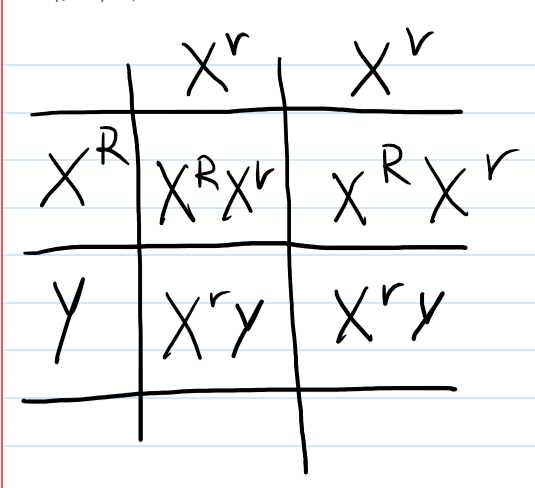
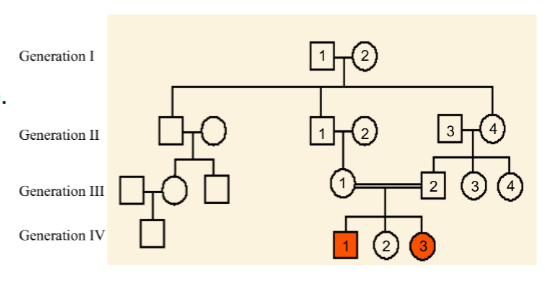
The pedigree below shows the passing on of straight thumbs (recessive) and Hitchhiker’s thumb (dominant). Shaded shapes mean the person has a straight thumb. Hitchhiker’s thumb is NOT an X-linked trait
a. Is individual IV-2 heterozygous or homozygous for this trait? Explain your answer.
b. Why is there a double line (as opposed to a single line) between individuals III-1 and III-2? (Hint: what is different about this pairing than the other matings shown on the pedigree, represented by a single line)
c. In this pedigree, straight thumbs is not a very common phenotype. Propose an explanation for why the only individuals on this pedigree that have the recessive phenotype are the offspring of
III-1 and III-2 and not any of the other matings shown on the pedigree
a. We cannot be certain, they could be either. Given that the parents are both heterozygous, and IV-2 does have hitchhiker’s thumb, they have a 33% chance of being HH and a 66% chance of being Hh.
b. they are related
c. Related individuals are more likely to carry the same recessive alleles. That means their offspring are more likely to inherit the recessive allele from both parents and express the recessive phenotype.
Domestication of animals frequently results in predictable changes in physical traits that are not directly being selected; examples include floppy ears, short/curly tails, white face markings, curly hair,
etc. Describe two genetic mechanisms that might explain why these traits are consistently more common in domesticated animals than their wild relatives
It is possible these genes are linked. If genes contributing to tameness are on the same chromosomes as genes relating to floppy ears, curly tails, etc, then breeding for tameness will also increase these other traits in the population.
It is also possible that the genes for tameness are pleiotropic and also impact these physical traits directly.

The pedigree below shows the inheritance of alkaptonuria, a biochemical disorder. This is NOT an X-linked trait. Males are shown with boxes and females with circles, purple shapes represent individuals with alkaptonuria.
a. Is this condition caused by a dominant allele or a recessive allele? Provide evidence from the pedigree to support your answer.
b. Which individuals’ genotypes can be deduced from this pedigree? Label all the persons whose genotype can be determined. Which individuals’ genotypes cannot be determined?
a. Recessive, since the only way Carla can have the disorder while Ann and Michael do not is if it is recessive.
b.
Ann: Heterozygous
Michael: Heterozygous
Carla: homozygous recessive
Tom: homozygous recessive
Wilma: homozygous recessive
Arlene: homozygous recessive
George: Heterozygous
Sam: Heterozygous
Daniel: Heterozygous
Alan: Heterozygous
You have isolated three new recessive mutations in Drosophila: green-eye (g), fuzzball (f), and crooked wing (c). You cross homozygous parents to create several heterozygous F1s with genotype GgFf, GgCc, and GgFfCc. A GgFf x ggff cross reveals the following gamete frequencies: 39% GF, 11% Gf, 9% gF, and
41% gf. A GgCc x ggcc cross reveals gamete frequencies of 49% GC, 2% Gc, 2% gC, and 47% gc.
Do these crosses suggest that the F and C genes are linked? Explain your answer
Yes. The crosses first determine if G and F are linked and then if G and C are linked. If these genes were unlinked, we would expect the resulting offspring ratios to be even. The offspring ratios are very uneven in both crosses, meaning that genes G and F are linked and genes G and C are linked. This then means that all three genes are on the same chromosome, indicating that F and C are also linked.

You are studying four recessive mutations in Drosophila: little wing (l), maroon body pigment (m), giant antennae (g), and big eye (b). You cross homozygous parents to create several heterozygous F1s with genotype LlMm, LlGg and MmGg. Crosses between the F1 individuals and homozygous recessive individuals (ex: LlMm x llmm) indicate gamete production in the following frequencies
a. Which of the four genes you are studying are linked?
b. Of the genes that are linked, which are closest together on the chromosome?
a. l and m, g and b
b. g and b
True or False: If the genotype frequencies of a given population add up to 1, then that population is in
Hardy Weinberg Equilibrium.
a. False
b. True
a
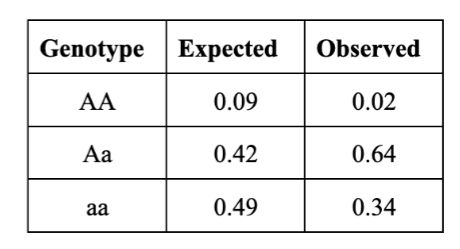
The table below shows the observed genotype frequencies in a population along with the expected genotype frequencies under Hardy-Weinberg equilibrium.
Which of the following can you conclude from this data?
a. The population follows all Hardy-Weinberg assumptions
b. Inbreeding is likely occurring
c. There is probably selection in favor of the heterozygote
d. Drift is likely high in this population
c
Which of the following is not a violation of Hardy-Weinberg assumptions?
a. Lizards preferentially choose mates with brighter dewlaps
b. There are ten different alleles for a particular gene
c. Foxes with tamer personalities are more likely to reproduce
d. A new allele arises in the population
e. A group of five bats colonize a new, previously uninhabited island
b
A gene for flower color in pea plants has two alleles, A and a. Given the following genotype frequencies, which of these populations shows evidence of possible inbreeding?
a. AA=0.01, Aa=0.30, aa=0.69
b. AA=0.04, Aa=0.32, aa=0.64
c. AA=0.25, Aa=0.5, aa=0.25
d. AA=0.20, Aa=0.39, aa=0.41
e. AA=0.09, Aa=0.42, aa=0.49
c
In many large mammal populations, highways can be barriers to movement - individuals rarely cross them. One solution to this problem has been to install overhead bridges for wildlife to safely cross. The goal is to increase gene flow between the populations on either side of the highway. Which of the following would you expect to see if the bridge is successful in its goal?
a. Higher levels of drift would occur in both populations after the bridge is installed
b. The two populations would have different mutation rates
c. The two populations would become more genetically similar
d. Both populations would decrease in size
e. More inbreeding would occur in both populations
c
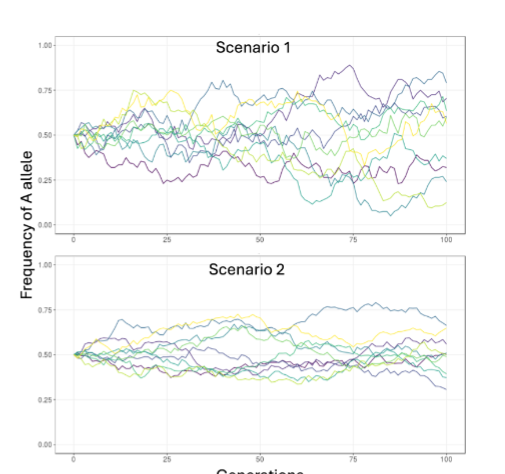
We conducted computer simulations under two different scenarios, shown in the two figures below. Each line represents a separate population simulated under that scenario. The figure below shows how the frequency of the A1 allele (y axis) changes over time (x
axis). Which of the following can you conclude based on this data (select all that apply)?
a. Scenario 1 represents a smaller population size than Scenario 2
b. The phenotype produced by the A allele is beneficial in Scenario1
c. A new mutation arose in this population in Scenario 1
d. The phenotype produced by the A allele is beneficial in Scenario2
a
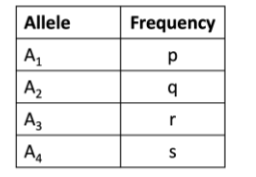
You are studying a population of grasshoppers and you find four different alleles at the A gene, with frequencies shown in the table. Assuming the population is in Hardy-Weinberg equilibrium, the frequency of genotype A1A3 is _________ and the frequency for genotype A2A2 is ___________.
pr, q²
A small population of 26 individuals has five alleles, A, B, C, D, and E for a particular gene. Five individuals are DA heterozygotes, five individuals are AA homozygotes, five individuals are AB heterozygotes, five individuals are CD heterozygotes, five
individuals are CC homozygotes, and one individual is an EE homozygote.
a. What is the frequency of each allele in this population?
b. If five AE heterozygotes migrate into the population, what will be the resulting allele frequencies?
a. A: 20/52, B: 5/52, C: 15/52, D: 10/52, E: 2/52
b. A: 25/62, B: 5/62, C: 15/62, D: 10/62, E: 7/62
A population of otters in H-W equilibrium has two alleles for fur color: D is dark brown and complete dominant to d, which is light brown. If 81% of the population has light brown fur, what is the frequency of homozygous dominant otters?
q2 = 0.81 so q = 0.9 p = 1-0.9 = 0.1 p2 = (0.1)2 = 0.01 ANSWER: 0.01
A population of plants in H-W equilibrium has two alleles (B and b) for flower color. The frequency of the B allele in the population is 0.7. What is the frequency of plants in this population that are
heterozygous for flower color?
p = 0.7 q = 1-0.7 = 0.3 2pq = 2(0.7)(0.3) = 0.42 ANSWER: 0.42
A nearby population of snails in H-W equilibrium has two alleles (R and r) for shell color. If the frequency of snails that are homozygous for R is 0.64, what is the frequency of snails that are homozygous for r?
p2 = 0.64 so p = 0.8 q = 1-0.8 = 0.2 q2 = (0.2)2 = 0.04 ANSWER: 0.04
A population of trees in H-W equilibrium has two alleles (F and f) for seed color. The frequency of trees heterozygous for seed color is 0.42. You know that the f allele is more common than the F allele in this population. What are the frequencies of each allele in this population?
2pq = 0.42 so pq = 0.21 so one allele is 0.7 and the other is 0.3. Question statesf allele is more common so p = 0.3 and q = 0.7
A population of geckos in H-W equilibrium has two alleles for tail length: L for long tails, which is incomplete dominant to l for short tails. The frequency of geckos with long tails is 0.36. What percent
of the population would you expect to be heterozygous?
Because the trait is incomplete dominant, p2 = 0.36 so p = 0.6 and q = 0.4
2pq = 2(0.6)(0.4) = 0.48 ANSWER: 0.48
A population of bison in H-W equilibrium has three alleles for horn shape: long (A), short (a) and curly (o). The long allele is dominant over both the short and curly alleles, and the short allele is dominant
over the curly allele. The frequency of the a allele is 0.5, and 16% of the population has curly horns.
a. What percent of the population has long horns? Hint: remember that long horns is a phenotype that represents multiple genotypes
b. Which of the three phenotypes (long, short, curly) is the most common in this population?
c. What is the frequency of homozygotes in this population?
a. Long horns: p2 + 2pq + 2pr = (0.1)2 + 2(0.1)(0.5) + 2(0.1)(0.4) = 0.01 + 0.1 + 0.08 = 0.19 → ANSWER: 0.19
b. Curly: 16% (stated in question), Long: 19% (part A), can calculate short horns two ways: Short: q2 + 2qr = (0.5)2 +2(0.5)(0.4) = 0.25 + 0.4 = 0.65 ANSWER: short
c.There are three homozygous genotypes: AA, aa, and oo. p2 + q2 + r2 = (0.1)2 + (0.5)2 + (0.4)2 = 0.01 + 0.25 + 0.16 = 0.42
Given the following genotype frequencies, is each of these populations in Hardy-Weinberg equilibrium? If not, determine which observed genotype frequencies are greater or less than expected
and propose an explanation for the observed phenotypes (ie. Which H-W assumption is violated?).
Note: there may be more than one possible explanation for the observed genotype frequencies
a. AA = 0.01, Aa = 0.18, aa = 0.81
b. AA = 0.25, Aa = 0.50, aa = 0.25
c. AA = 0.36, Aa = 0.60, aa = 0.04
d. AA = 0.09, Aa = 0.42, aa = 0.49
e. AA = 0.64, Aa = 0.20, aa = 0.16
A. in HWE
B. in HWE
C. no in hwe, could be genetic drift torwards A, outbreeding, or stabilizing selection
D. in HWE
E. not in HWE, could be due to genetic drift or inbreeding
How are the founder effect and a population bottleneck similar? How are they different? Which one would you predict to have a more serious negative impact on the species as a whole?
Both are a reduction in the gene pool of the population under consideration through reduction in population size. The major difference is that for a founder event, the larger original population still exists and can maintain genetic diversity (and possibly contribute it to the founder population through migration). In a bottleneck event, the small population is all that remains and whatever genetic diversity is (or is not) present there is all the species as a whole as left. Consequently, the bottleneck is more likely to have severe negative consequences for the species.
Describe the consequences of genetic drift. Why are small populations more affected by drift than larger populations?
Genetic drift causes an overall reduction in genetic diversity (through loss/fixation of alleles), increases in inbreeding, increases in homozygosity, increases in deleterious recessive conditions, increased susceptibility to future stressors like disease or climate change. Small populations are more affected because there are fewer ‘chances’ for rare alleles to get passed on.